Review: UMMA's "Europe on Paper: The Ernst Pulgram and Frances McSparran Collection"

Europe on Paper at the University of Michigan Museum of Art certainly delivers everything it says in its title. But as is often the case at the UMMA, there’s a lot more to this exhibit than meets the eye.
For the display is a handful of seriously handsome artworks on paper. And as Lehti Mairike Keelmann, UMMA Assistant Curator of Western Art says in her introduction to the exhibit:
[T]he 47 prints, drawings, and watercolors comprising the Ernst Pulgram and Francis McSparran Collection provide a unique perspective on a momentous change in European history.The works were made between the 18th and mid-20th century,” says Keelmann, “as the continent industrialized and new modes of transportation began to crisscross the countryside, connecting growing cities. Geopolitical tensions arose as nations attempted to bolster their identities on the world stage, culminating in the violence and turmoil of the two world wars.
And as if these geopolitical upheavals weren’t dramatic enough, there was pretty good art being made all over the place, too. That’s where Pulgram and McSparran come into play. A young and adventurous couple as they had to be, they consistently evaluated and scooped up some of the finest personalized art of this explosive period through their lifetimes.
PowerArt! Profile: David Zinn
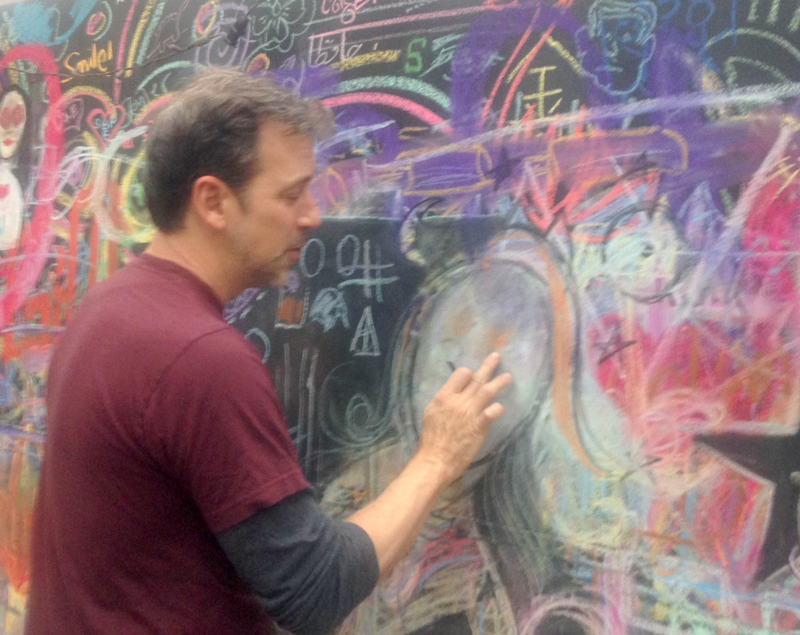
David Zinn's art is all over Ann Arbor, but you may not know it.
In addition to two PowerArt boxes recently installed at Main and William (PenPals) and at Liberty and First Ave (Selfie Monster) as part of the PowerArt Project, the Ann Arbor native is also responsible for the witty trompe l'oeil rendition of Singin' in the Rain which can be found on Fifth Avenue across from the Ann Arbor Public Library's downtown branch. And recently he was one of the artists represented at Ann Arbor Art Center's Pop-X Festival.
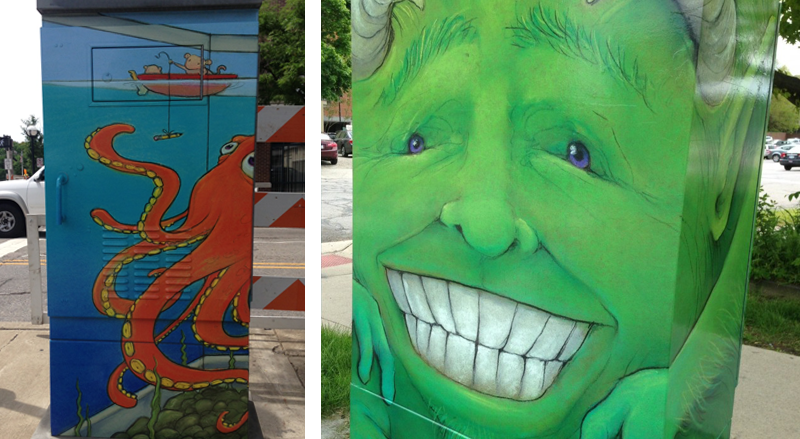
David Zinn is best known, though, as a master of comic ephemerality. He creates improvised temporary street art entirely from chalk, charcoal and found objects. His works feature fanciful creatures that pop into and out of our dimension, visitors from his wild imagination. He likes "walking around seeing places where art wants to be and putting it there."
Zinn's improbable career as a street artist began about 14 years ago as an escape from the tedium of his job as a graphic designer:
"The first day I did this, I had a really important job that I had to finish in two days, and I should have been sitting in front of my computer doing this very important job and doing all the very important things I was supposed to do. It was completely childish and irresponsible to go outside, but it was a beautiful day. The sun was out, it was 76 degrees and that does not happen here every day. And it made sitting in front of a computer seem kind of irrational."
Zinn's temporary artworks are relentlessly cheerful and entertaining. Sluggo, an amorphous blob with eyes on stalks and Philomena, a pig with wings, make frequent appearances in his temporary artworks along with a wide array of tiny monsters, valiant mice, elves and some creatures that are frankly, impossible to categorize. They bubble up out of his subconscious and dissipate just as quickly.
Zinn spends quite a bit of creative energy in subverting the status of his works as permanent art objects. He is not interested in showing his work in galleries, or in treating them as objects to venerate as high art. He values spontaneity and surprise above all.
"If it isn't going to be destroyed there's a lot I should be worrying about right now-- whether it’s good enough, whether it's serious enough. II feel bad for painters who paint conventionally on canvas, because when you finish a canvas, no matter whether you sell it, give it away or keep it in your attic, these are all things that you now have to do...but if you can't take it home, or somebody's going to eat it, or it's going to get rained on anyway, then you're free to just do what's going to make you happy now. And if you like it you can take a picture."
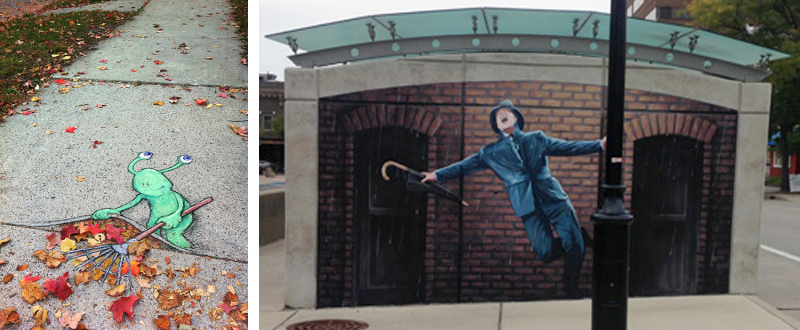
And that's exactly what David Zinn has done. He recently published a thoroughly entertaining book of his favorite temporary chalk artworks entitled Temporary Preserves. It includes not only pictures of his outdoor creations, but also photos of many of his smaller efforts made on the tables of restaurants in Ann Arbor during Michigan's cold winter months.
"The rationale for the book is that I went out on the sidewalk to get away from the computer and it was an increasingly sad irony to observe that now what I did to get away from the computer, people are sitting at the computer to look at."
K.A. Letts is an artist and art blogger. She has shown her work regionally and nationally and in 2015 won the Toledo Federation of Art Societies Purchase Award while participating in the TAAE95 Exhibit at the Toledo Museum of Art. You can find more of her work at RustbeltArts.com.
Take a walk and see the PowerArt! boxes up close and personal; a map of PowerArt! box locations is available to download. PowerArt is a partnership between the Ann Arbor Downtown Development Authority (AADDA) and the Ann Arbor Public Art Commission (AAPAC), The Arts Alliance is managing the selection and installation of artwork by local artists on power boxes throughout downtown Ann Arbor. You'll find more info about the project at the Arts Alliance website.
Review: Unsettled: The Work of Edward Gorey

Edward Gorey: lover of cats, ballet, Victorian/Edwardian era aesthetics, fur coats, pen-and-ink drawings, the color black and bats. Becoming a fan of Gorey has come in/out of fashion many times over the years, but since his death in 2000 he has only grown in the public consciousness. If you don’t know Edward Gorey’s work you surely know of the legions of other artists who were inspired by his work. From Tim Burton to Lemony Snicket, and goth culture to steampunk Gorey’s influence is felt far and wide. And from Neil Gaiman to Emily the Strange, and Lenore all things, dark, atmospheric and vaguely historical likely started with a love of Edward Gorey. Gorey’s black and white aesthetic lends itself to tattoo work, and often seeing a Gorey inspired tattoo will be for some their first glimpse into his macabre and hypnotizing world view. Many people also discover Gorey from the many New Yorker covers he did, as well as the animated credits for PBS's Mystery!
Unsettled: The Work of Edward Gorey @ the Cranbrook Art Museum, in Bloomfield Hills, MI opened September 18, 2016 and will be on display through March 12, 2017. The show is a perfect primer for entering the pen-and-ink world of Gorey’s illustrations. Gorey was a prolific illustrator who started working in the 1950’s for Doubleday publishers in NYC as their in house illustrator. It was here he honed his craft and illustrated classics like Dracula by Bram Stoker, The War of the Worlds by H. G. Wells, and Old Possum's Book of Practical Cats by T. S. Eliot. Later, he became known for illustrating most of children’s author, John Bellairs’s books, starting in the 1970s and continuing in the 90s.
The exhibit is a collection on loan to the museum from a local collector and it serves as an excellent overview and entree to the work of Edward Gorey. Newbies and devoted fans will both enjoy the variety of work on display and the opportunity to ponder and look closely at his detailed drawings. The size of the works and his simple yet complex use of black pen and ink begs to be more closely inspected.

The majority of what is on display are the wide variety of books that Gorey illustrated for others as well as his own works such as: The Curious Sofa, The Beastly Baby The Sopping Thursday, and his most well known book The Gashlycrumb Tinies. Knowing that most of his original illustrations were the size that they were published makes his meticulous detail even more impressive.
The original prints, posters and ephemera are also a thrill to see. From the large framed poster print of the 1977 Broadway revival production of Dracula that he designed the sets for to the 3D replica of the stage set, that allows you to do your own version of the play, it’s a wonderful sampling. A bean bag filled Gorey bat with red rhinestone eyes, The Fantod Pack - Gorey’s version of a Tarot card as well as a few rare stuffed cats and pigs were also on display. The impossibly miniature and rare books on display are a joy to see - smaller than 2 inches in diameter with full, detailed illustrations.
Gorey’s humor is dark, clever and at times make you feel uncomfortable, but you may also find yourself smirking with knowing glee at the black humor and the dangerous places he fearlessly takes his audience.
Erin Helmrich is a librarian at the Ann Arbor District Library and an avid collector of Edward Gorey's books and more. She has three tattoos of Gorey's work - all black of course.
Unsettled: The Work of Edward Gorey is on display through March 12, 2017. Museum admission is $10 for adults and the exhibit is included in this fee. More information about the exhibit and the museum can be found here.
Review: "Catie Newell: Overnight" at the University of Michigan Museum of Art

I’ve always thought it was just me. That is, that my comfort with the night’s glimpse into the unknown was an element I alone enjoyed.
Little could I know that Catie Newell: Overnight at the University of Michigan Museum of Art’s Irving Stenn, Jr., Family Project Gallery would be such a vivid entry in the outsider’s world of artful darkness.
Atmospheric darkness is a rather difficult concept with which to fully come to terms. Simply said, there’s a seeming absence of something—through the presence of nothing.
Perhaps night light is the unacknowledged underbelly of the sublime - that exalted aesthetic quality distinct from manmade beauty. Which is to say, what we appreciate in nature is supposedly qualitatively different from the pleasure we receive from viewing art.
Think along the lines of standing aside Yosemite’s Half-Dome; overlooking Lake Superior at the Upper Peninsula’s Pictured Rocks Natural Lakeshore; or contemplating the dazzlingly azure beauty of Italy’s Amalfi coastline. All are indeed awe inspiring experiences.
But this yawning of nature’s infinity has always been a troublesome concept—or, at least, I’ve always thought it so. If only because there can also be no mistaking of the thrill to be found standing dead-center in the junction of New York City’s Broadway and Seventh Avenue at Times Square; or studying the overwhelming intricacy of Chartres cathedral; or, for that matter, walking the expansive panorama of St. Peter’s Square.
Yet all these glorious experiences—as magnificent as they may be—do not really hit the curious spot of simple night light. And Newell’s Overnight is as handsome an exploration of this singularity as one is bound to find.
It’s definitely been a long time coming for someone whose favorite backdrop encompasses the night’s perimeters.
An Assistant Professor of Architecture at the University of Michigan’s Taubman College of Architecture and Urban Planning, Newell joined that faculty in 2009 as their Oberdick Fellow after receiving her Masters of Architecture from Rice University and a Bachelor of Science in architecture from Georgia Tech University.
Winner of the 2011 Architectural League Prize for Young Architects and Designers; the 2011 ArtPrize Best Use of Urban Space Juried Award; and the 2011 Architectural League Prize for Young Architects and Designers, Newell has exhibited at the 2012 Architecture Venice Biennale. And after attaining the Cynthia Hazen Polsky and Leon Polsky Rome Prize Fellow in Architecture for 2013-2014, she’s now a Fellow of the American Academy in Rome.
UMMA Director Joseph Rosa and Exhibit Manager Jane Dechants say in their introduction to the exhibit, “Newell’s fascination with light is also a fascination with darkness."
“Darkness and its surrogates—ambient light; residual light; shadows, haze, and other ‘interruptions’—give the environment what she calls its double-life in daytime. A landscape may be seen and known—familiar, predictable, trustworthy—but at night it succumbs to a darkness that, in her words, removes its walls, alters its spaces, and haunts—becoming risky, even dangerous, and ultimately alien.”
This nod to darkness—and the strategic absence of darkness—is the essential element of Newell’s installation and its spectacular accompanying untitled color photography.
Newell writes in her gallery statement, the “installation is attuned specifically to the gallery’s exposure to daylight and its transformation into night. During the day, natural illumination catches reflections on the aluminum wire, and provides the best light to view the 'Nightly' [color photographic] series.
“In the evening hours after sunset and for the duration of the show, the Museum will leave its exterior lights off, allowing the installation spotlights to draw out different lines of light on the aluminum [Overnight] and create the impossible architectural moment captured in the 'Nightly' series.”
Impossible might indeed be the right word here. Because these observations indirectly infer that what one sees of Overnight is only a portion of what one does not see—at least not directly.
The installation definitely is a nocturnal treat to observe overnight. Two chevrons of multi-strand aluminum wires shimmering as they hover from the gallery’s ceiling with a single spot light shining on each aggregation, Overnight is haunting in its suspension. Tiny LED lights at the bottom of selected strands give occasional bursts of light as one passes the UMMA. There’s a decidedly ghostly ambiance to the work.

Yet perhaps it’s the photographs that are the most distinctive element of the exhibit. A series of 19 color photographs set in irregular groups of two, three, and four images around two walls of the Stenn Gallery, the 'Nightly' series is easily some of the most dramatic photography seen in Ann Arbor through this last year.
Each composition is really no more than a strategically placed spotlight that captures the mood of its surrounding landscape in an otherwise ordinary urban setting. The nocturnal iridescence of this light creates an otherworldly intimacy that dramatically dominates the photo’s milieu. As such, perhaps the most overwhelming effect of this masterly work is Newell’s keen sense of the psychological tension this imagery can have on its viewer.
If it’s a valid truism that profundity of art lies in simplicity, Newell has crafted some of the most insightful art we’re likely to see any time soon. Playing off the observation that absence can have as strong an attraction as presence, the simplicity of Newell’s Overnight installation and her 'Nightly' series is as visceral an experience as art can be.
John Carlos Cantú has written on our community's visual arts in a number of different periodicals.
University of Michigan Museum of Art: "Catie Newell: Overnight” will run through November 6, 2016. The UMMA is located at 525 S. State Street. The Museum is open Tuesday-Saturday 11 am - 5 pm; and Sunday 12–5 pm. For information, call 734-764-0395.
Halloween Events Around Ann Arbor
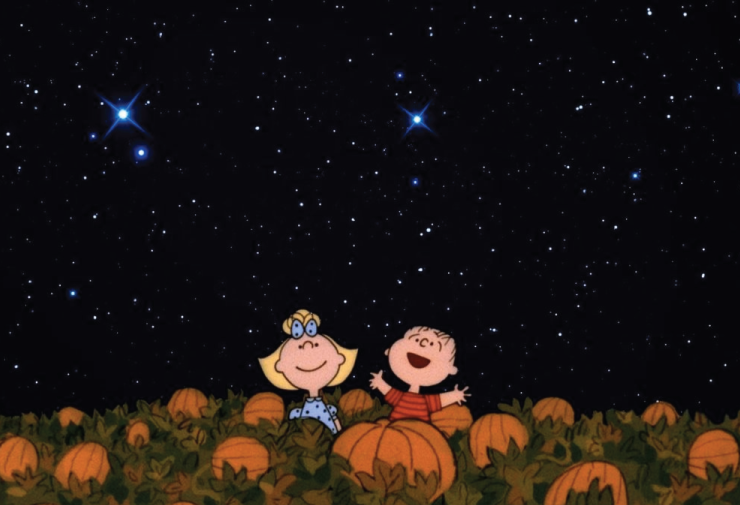
If you're looking for some fun events around town for the Halloween weekend, read on for creepy cemetery tours, devilish dance parties, shadow puppet theatre, and more Halloween arts & culture:
Book-Themed Halloween Costume Contest
Monday, October 31st - 10:00am-9:00pm
Literati Bookstore - Ann Arbor, MI
Halloween at the Market
Saturday, October 29th - 12:00pm-2:00pm
Ann Arbor Farmer's Market - Ann Arbor, MI
Highland Cemetery Lantern Tours
Sunday, October 30th - 7:00pm-9:00pm
Highland Cemetery - Ypsilanti, MI
Shadow Puppet Double Feature
Saturday, October 29th - 9:00pm-11:00pm
Triple Goddess Tasting Room - Ypsilanti, MI
Cultivate Masquerade & Costume Bash
Friday, October 28th - 8:00pm-12:00am
Cultivate Coffee & Taphouse - Ypsilanti, MI
Black Cat Cabaret - Neighborhood Theatre Group
Friday, October 28th and Saturday, October 29th - 8:30pm
Bona Sera - Ypsilanti, MI
Halloween Treat Parade
Monday, October 31st - 11:00am-5:00pm
Main Street Area - Ann Arbor, MI
A2DC Presents: Hullabaloo Halloween Spooktacular
Sunday, October 30th - 6:00pm-10:00pm
Ann Arbor Distilling Company - Ann Arbor, MI
The Bang! Halloween Dance Party
Saturday, October 29th - 9:30pm
The Blind Pig - Ann Arbor, MI
Nightlife Arcade Gaming Spooktacular
Friday, October 28th - 6:00pm-9:00pm
The Forge by Pillar - Ann Arbor, MI
Preview: ypsiGLOW
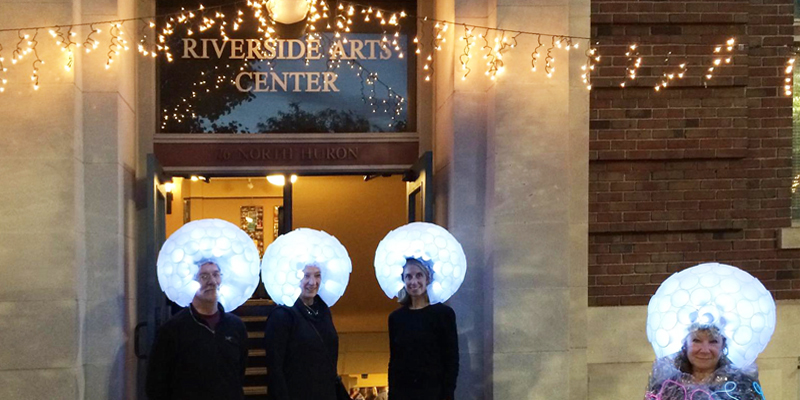
YpsiGLOW--the first annual family-friendly, multi-sensory light, art, and music celebration of fall--will be held in downtown Ypsilanti this Thursday, October 27. Festivities commence at 5 pm at the Main Branch of the Ypsilanti Public Library at 229 W. Michigan Avenue with a preGLOW kid's costume party. Treats, activities, games, and a costume contest will be followed at 6:30 pm by a walking costume and luminary parade from the library to the nearby ypsiGLOW block party on Washington between Pearl and Michigan Avenue.
As a DJ spins tracks from his scissor-lift perch, a UV light-activated dance floor and blacklight animated alleys provide space for costumed adults and kids to move with the music. YpsiGLOW artists will perform on the street and in shop windows. Blacklight body artists will be on hand to paint faces and make hair glow in the dark. Also featured will be a blacklight reactive superhero mural, a giant luminary skull, a six-foot-tall grizzly, jack-o-lanterns, shadow puppets, and much more. Dancers from the WCC Performing Arts Department and the EMU Dance crew will perform, and films and projections will light up the night. Costumes are encouraged, trick-or-treaters are welcome and stores will be open until 9:30 pm. There is ample free parking on streets and in city lots for the event.
And for adult GLOWers who want to continue the party, there is an afterGLOW in the spooky black cellars of Bona Sera with DJ Ryan Gerald until midnight.
It took a village to get this event going. It began two years ago when members of the Washtenaw Convention and Visitors Bureau, The Downtown Association of Ypsilanti and Wonderfools Productions (of Ann Arbor Festifools fame) decided a Halloween-season festival would be a great addition to Ypsilanti's already very successful First Fridays. Wonderfool organizers Shary Brown, Mark Tucker, Jeri Rosenberg, and Adriana Zardus began meeting with creative members of the Ypsilanti community, the Ypsilanti Public Library staff, and local educational institutions as well as with civic leaders. Together, they developed a plan to leverage the outsize creative capital of Ypsilanti, the under-utilized downtown real estate, and a little seed money to create the one-night annual cultural festival that is ypsiGLOW.
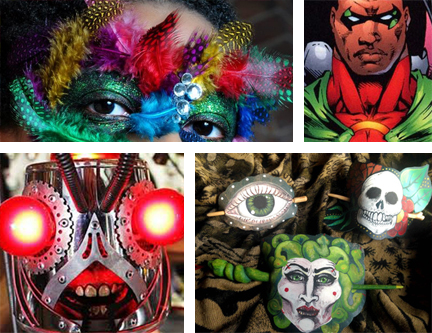
I asked some members of the Wonderfool production team about their process:
"Two of our first partners were Barry LaRue and Will Hathaway of Riverside Arts Center. They, in the space of less than a week, had sent out email introductions. So we spent two and a half to three months just meeting people," says Shary Brown.
Adriana Zardus adds, "Those three months were really important--we called it our discovery phase. We weren't prescribing any ideas. We were just saying that this is what our organization does: we connect different businesses, artists, and community organizations together to make their own creative vision... There's such a wealth of artists and creatives and community leaders that it was the easiest thing in the world to let go of the creative reins and hand it over.”
One thing that was very clear to the team from the start though, was that the event had to have its own unique Ypsi character that to showcase the strengths of this diverse artist, musicians, and creatives-rich community, starting with the choice of a name. They came up with ypsiGLOW in consultation with community members. It was an instant hit.
"GLOWing is positive, it's artistically descriptive and appropriate for the season,” says Shary Brown.
To prepare for the big night, 23 ypsiGLOW workshops have been held by community and arts organizations like Ozone House, Project 23, FLY Children’s ArtCenter, and many others. Masks, jack-lanterns, luminaries, and giant light creatures are now ready to make the night GLOW.
YpsiGLOW will get its first airing this Thursday but certainly not its last. The Wonderfool production team and Ypsi’s artists, educators, businesses, and community leaders are hoping to start an annual tradition that will bring everyone in the Ann Arbor/Ypsi area together for a satisfying shared community art experience for all ages.
K.A. Letts is an artist and art blogger. She has shown her work regionally and nationally and in 2015 won the Toledo Federation of Art Societies Purchase Award while participating in the TAAE95 Exhibit at the Toledo Museum of Art. You can find more of her work at RustbeltArts.com.
The first ypsiGLOW is Thursday, October 27, 2016, from 6:30 pm to 9:00 pm at Washington Street (between Pearl St. and Michigan Ave.) in Ypsilanti. Glow-gear and costumes are strongly encouraged.
Review: Free Wet Hugz | 94th Annual All Media Exhibition
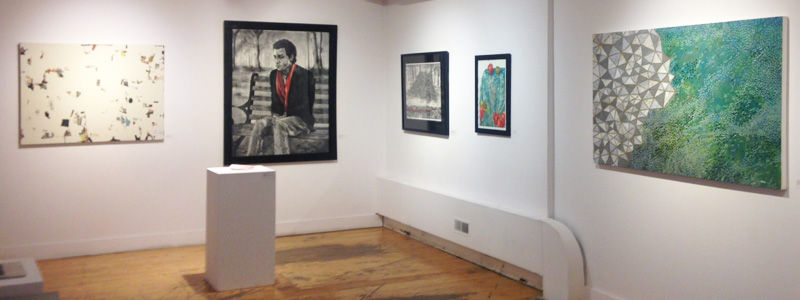
There's a lot to love and hate in an all media art exhibit.
On the plus side there's plenty to look at and much of it is wonderful. An all media show can provide visitors with a tantalizing array of original ideas and novel approaches to making art. It can be energizing and thought-provoking. On the other hand, it can seem like an all-you-can-eat buffet, and feelings after a visit can feel like aesthetic indigestion from an overdose of visual sensation.
Paul Kotula, this year's juror for Free Wet Hugz, the 94th annual all media show at Ann Arbor Art Center's 117 Gallery, has spared us an art bellyache with his judicious editing and careful arrangement of the works on display. This exhibit features about a third fewer entries than last year's, with the result that the art that's included has room to breathe.
Kotula has chosen to put his emphasis on abstract painting, and this is some of the strongest work in that medium I've seen locally in quite some time.
I have always liked John McLaughlin's small drawings, but had reservations about his larger paintings, which seemed busy and disorganized to me. With Drawing a Blank, McLaughlin seems to have resolved the question of how much visual incident to include in this larger format. His abstract but referential fragments feel comfortable on the picture plane and just right.
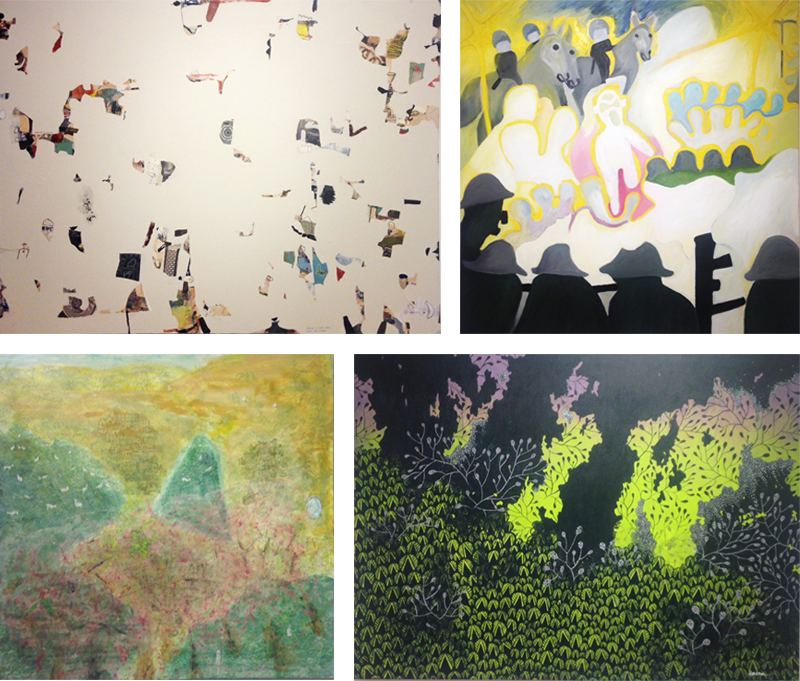
Rocco DePietro's Night Demonstration, with its horses, helmeted men and gas masked central figure puts me in mind of German expressionism of the early 20th century, and it’s his best painting to date.
And there is also plenty of wonderful work by artists who are new to me. A dreamy painting by Yuling Chuang entitled Exist, Co-Exist: Harmony 2, is composed along the lines of a traditional Chinese map. Diminutive line drawings of toy-like cities share the landscape with tiny white ghost figures.
Also impressive are two paintings by Haena Kang. In Boundless and Embrace she employs pattern painting to create the impression of undulating seascapes, or perhaps kelp beds.
Let's Dance by Chia-Yi Huang, Scenario by Jack St. John, and the ambitiously scaled Abstraction #14 (Meltdown) by Dennis Jones are terrific examples of abstract painterly painting. In a more figurative vein, Chaos in Captivity by Jean-Paul Aboudib and No Fear by Nathan Margoni are powerful and disturbing.
There were fewer works of photography and sculpture than in years past, but they, too show the result of careful curation. Most of the sculpture consists of simple assemblage like Folded Drawing 5 and Folded Drawing 8 by Ruth Koelewyn, edging over into installation with In Memorium by Gloria Pritschett and Loraine Lynn’s glass, wood and brick construction, 85 Hours. Bruce Giffin, a gifted photographer who is well-known for his pictures of Detroit and its residents presents us with Bill and His Chihuahuas. A small, remarkable photo, Conduct Becoming: Surveys #3 and #4, by CJ Breil, tells the entire life story of an elder couple in a single image.
On the basis of the paintings alone, Free Wet Hugz deserves a visit and when you add in the small but choice selection from other media, it's a no-brainer.
K.A. Letts is an artist and art blogger. She has shown her work regionally and nationally and in 2015 won the Toledo Federation of Art Societies Purchase Award while participating in the TAAE95 Exhibit at the Toledo Museum of Art. You can find more of her work at RustbeltArts.com.
Free Wet Hugz: 94th Annual All Media Exhibition is on display through Saturday, November 12, 2016 at the Ann Arbor Art Center, 117 W. Liberty St., Ann Arbor, MI. 48104.. More information about the exhibit can be found at the Art Center's website.
PowerArt! Profile: Cathy Jacobs
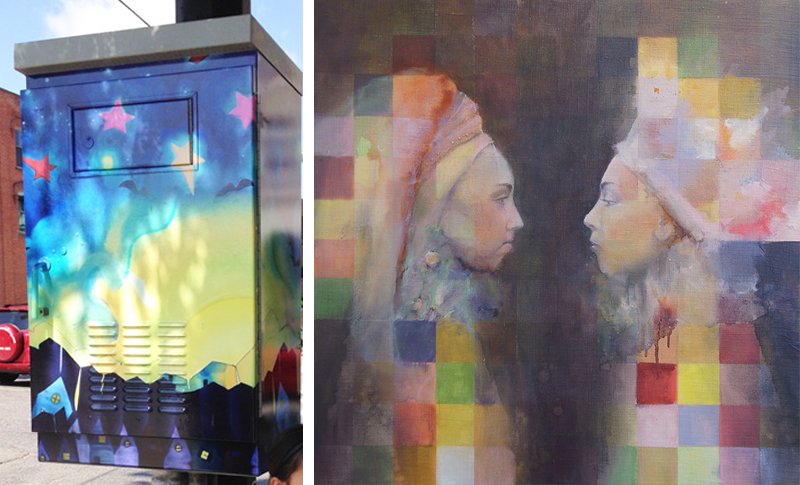
Cathy Jacobs doesn't remember not being an artist. As a child she sat at the vanity of her upstairs bedroom drawing obsessively for hours.
"I was always drawing from the time I was 3 or 4. When I was 7 or so, I thought I can be an artist! I had a vision of a sort of Salvador Dali character in a beret and a pencil mustache."In fact, she remembers dressing up as the surrealist master for Halloween one year. This seemed perfectly natural to her, since art was a man's world at the time.
"I always thought I’d grow up to be a man” she says, laughing.
The image Starry Sky that was chosen for the PowerArt Project box now installed at Miller and Main in Ann Arbor, comes directly from her childhood memories. She vividly recalls looking out of her bedroom window at the night sky and the houses in her Ferndale neighborhood. "I didn't like that they were so uniform, so I invented columns and balconies for them in my mind," she says.
Jacobs' interest in painting and drawing was a constant throughout her childhood and adolescence and was followed by college art studies. She studied painting at Wayne State University where she earned a B.F.A. and continued at Eastern Michigan University where she graduated with a Master of Fine Arts in Painting degree in 2015.
Her paintings from this period are figurative and show a strong interest in fantasy and storytelling. Fairytale archetypes and mysterious situation, puppets, dolls and queens populate her pictures. They have the quality of half-remembered dreams, fascinating and just out of reach.
Her work at this time was well composed and expertly painted, but Jacobs felt dissatisfied. She wanted the color, translucency and light in her paintings to escape from the picture plane and from narrative imagery. She experimented with various sheer or translucent materials--metal screen, gauzy silk and the like--collaged onto her paintings. The kind of lightness and atmosphere that she wanted seemed impossible to achieve with the media at hand.
But then, in 2014, Cathy Jacobs discovered weaving. Finally, this new medium allowed her to escape the painted canvas and the drawn image.
"It immediately took hold of my imagination. Through weaving, I found that I could express the full spectrum of colors and moods, but in real 3-dimensional space...I learned weaving and all of a sudden all the things I was thinking about in my paintings, the depth you would get through layers of color and translucency, I found I could get in 3 dimensions."
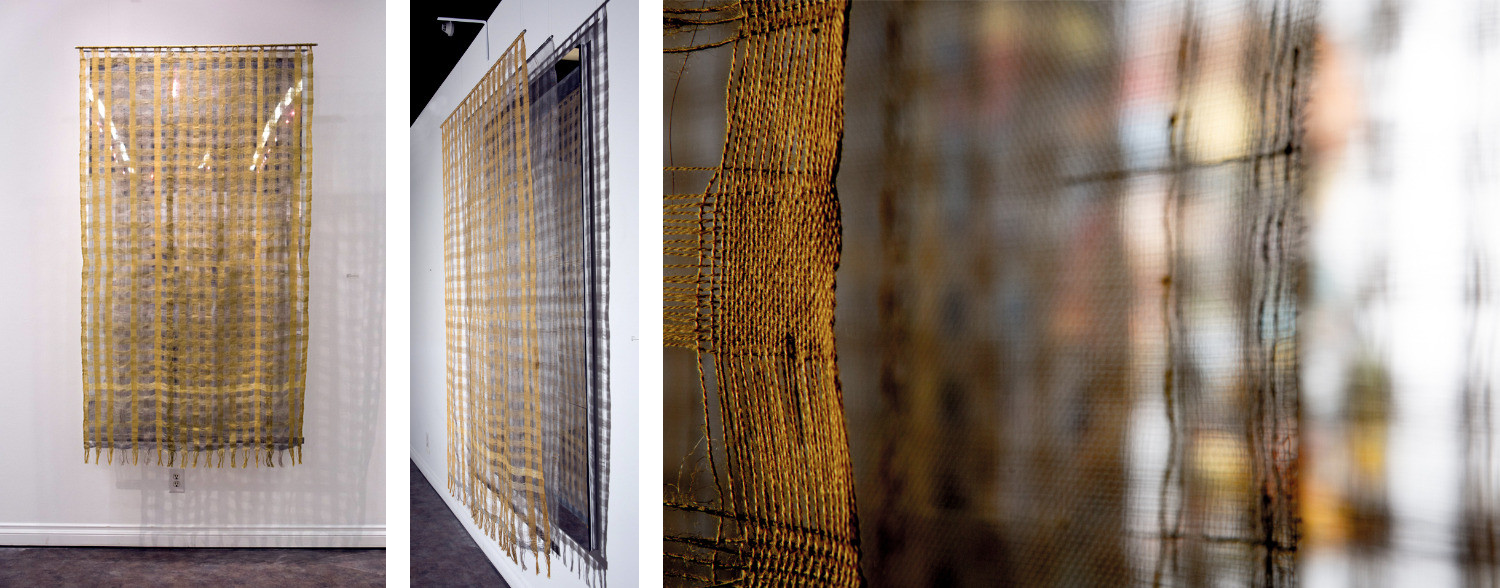
Cathy Jacobs sees the way before her clearly now. "My current focus is in weaving panels of linen that, when layered together create vibrating fields of color." She has already had some success, exhibiting her woven panels at Sofa Chicago 2015 on Navy Pier, and in the 2016 Architectural Digest Design Show in New York City. This fall, her work will be featured in World of Threads in Ontario, Canada.
Jacobs enjoys both the process of weaving and "the sense of finality and completion that comes when I finish a piece“ She seems to have found the means and medium to bring to the real world the contents of her imagination. Every working artist knows that this clarity is a temporary thing in a long creative life. Cathy Jacobs is a young artist and the future may see changes in her art practice, but for now she is happy in her woven world.
"It feels like a really good fit," she says, smiling.
K.A. Letts is an artist and art blogger. She has shown her work regionally and nationally and in 2015 won the Toledo Federation of Art Societies Purchase Award while participating in the TAAE95 Exhibit at the Toledo Museum of Art. You can find more of her work at RustbeltArts.com.
Take a walk and see the PowerArt! boxes up close and personal; a map of PowerArt! box locations is available to download. PowerArt is a partnership between the Ann Arbor Downtown Development Authority (AADDA) and the Ann Arbor Public Art Commission (AAPAC), The Arts Alliance is managing the selection and installation of artwork by local artists on power boxes throughout downtown Ann Arbor. You'll find more info about the project at the Arts Alliance website.
Ann Arbor Area Artists at ArtPrize 8
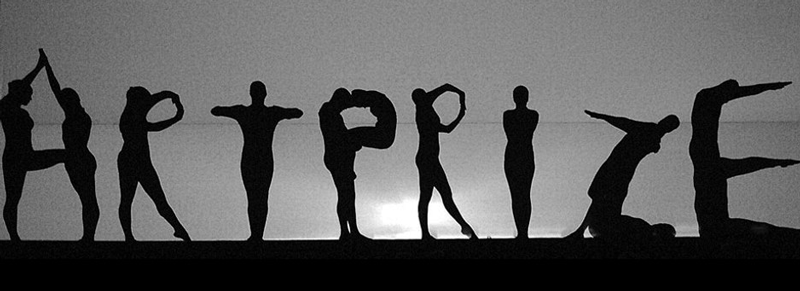
It's official – ArtPrize 8, the "radically open international art competition" in Grand Rapids, Michigan, now boasts the largest attendance to an art event on planet Earth. The 19-day event is now over for this year, the votes have been tallied and the 2 Grand Prize Winners (as well as the winners of the Category Prizes) have been announced.
Visitor numbers for this year have yet to be tallied, but from a mere 200,000 visitors in 2009, last year's event drew over 400,000 visitors from all 50 states and 47 countries. Clearly, ArtPrize has been and continues to be a wildly successful and popular art event that has put Grand Rapids on the cultural map.
Artist participation has fallen slightly from a high of 1,713 in 2010 to this year's 1,453. In a tacit admission that the event may be more of an unmixed blessing for the town than it is for the artists, additional prize money has been added to the two whopping $200,000 Grand Prizes in the form of 8 smaller $12,500 prizes in 2-dimensional, 3-dimensional, time-based, and installation categories (both voted by the public and juried)–plus a juried prize for best curated venue. Grants totaling $280,000 have also been awarded to artists, curators and venues for fabricating and installing site-specific artworks and exhibits.
Five entries from the Ann Arbor/Ypsi area were on view in Grand Rapids this year, and they are representative of the diverse backgrounds and professional experience of ArtPrize artists overall:
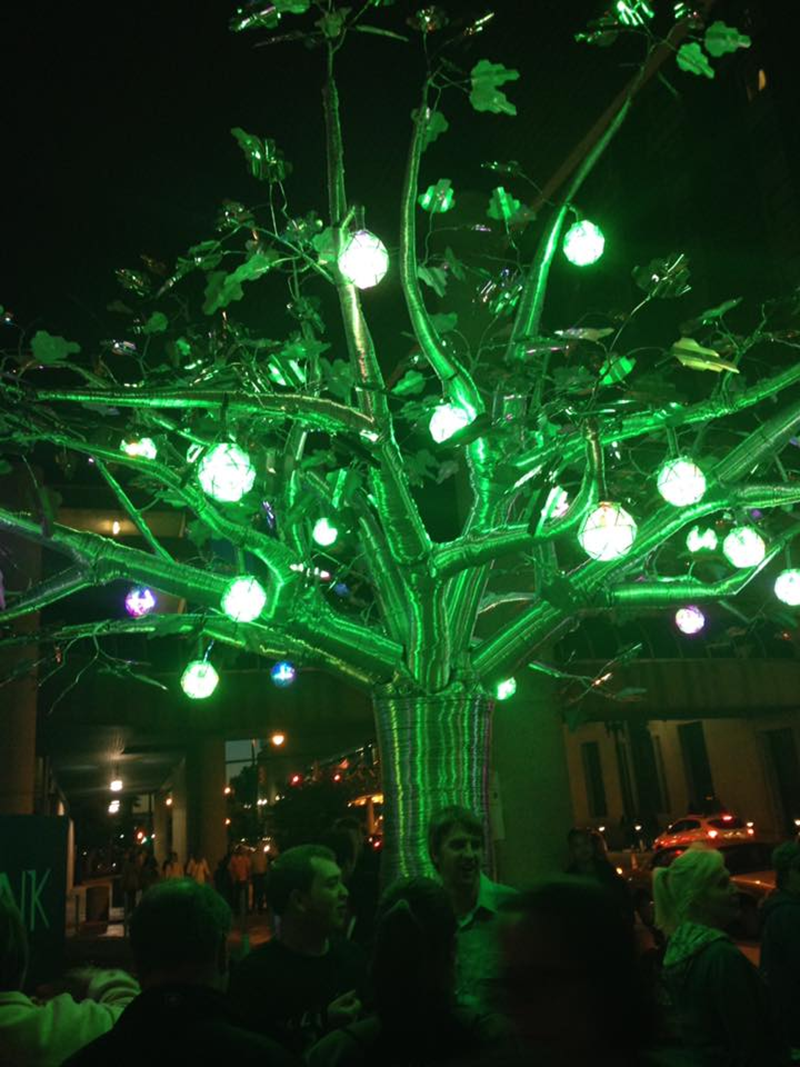
One Ann Arbor/Ypsi entry, Invasive Species by Shiny Seed, managed to make it into the prestigious final round of 20 for the $200,000 Public Choice Award, although the top prize ultimately went to Wounded Warrior Dogs by James Mellick of Milford Center, Ohio. (The Juried Grand Prize went to The Bureau of Personal Belonging by Stacey Kirby of Durham, North Carolina.)
Invasive Species, a giant aluminum-wrapped and LED-festooned tree, is a collaborative effort by software/electrical engineer and sculptor Gene Foulk and Casey Dixon, artist and shop manager of Maker Works in Ann Arbor. Invasive Species displays in abundance the qualities that can seize and hold the attention of the ArtPrize public and win their votes. It is figurative, centrally located, monumental in scale. It also demonstrates the technical mastery of the artists, is meticulously crafted and expresses commonly shared values in its environmental theme.
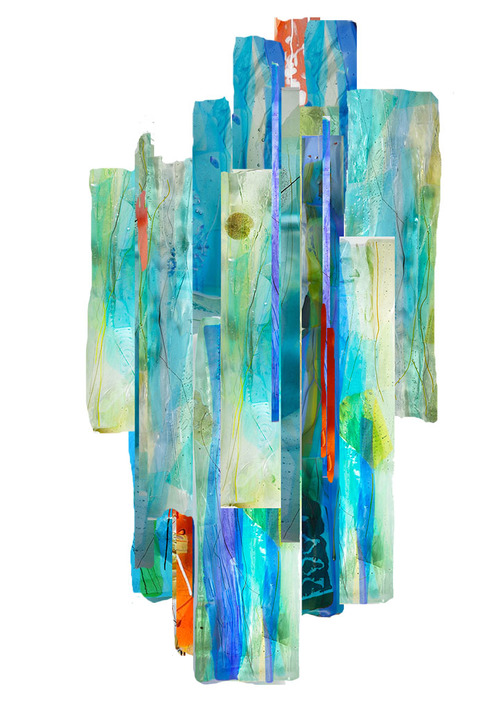
ArtPrize 8 is Ann Arbor glass artist Janet Kelman’s first experience with the event. She has been creating works of art in glass since she fell in love with the material while studying chemistry in college. Her wall-hung relief/assemblage Oracle was installed on the second floor of the Gerald R. Ford Presidential Museum.
Kelman is drawn to water and images of water, and her latest work is an exploration of that fascination. Oracle is one of a series on this theme. It is deceptively simple in form but complex in execution. Composed of 16 separate layers of fused glass displayed at varying distances from the wall, the panels overlap and interrelate in color and shape. She describes her process, saying, "I create small glass pieces using threads of glass, enameled images, crushed glass, whatever else I can dream up, and assemble them in layers on a kiln shelf. The finished fused glass always provides surprises, its constant allure."
Other work by Janet Kelman can be seen at WSG Gallery in Ann Arbor and Vale Craft Gallery in Chicago.
Megan Foldenauer, whose time-based drawing and video How to Draw the Human Eye was on view at the Women's City Club, has lived and worked as an artist in Ypsilanti for 11 years. Her virtuosic pencil drawings of a wide variety of single human eyes arranged in a grid around a small video screen make excellent use of her background in anatomy and medical illustration. She claims she has always known how to draw: "I'm one of those 'all of the sudden I could draw' types. A gift, a calling, a life’s purpose, whatever you wanna call it – I didn’t have to work-work-work to be able to draw… it’s just something I can always remember doing."
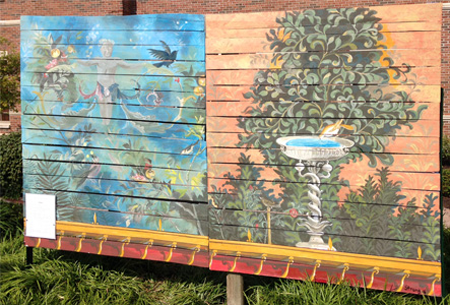
A freestanding diptych by J. Daniel Strong was installed in a corner park a bit off the beaten path during ArtPrize. Strong is an Ann Arbor muralist who usually works on commission. The imagery on the front of Pallet is based on Roman paintings in Pompeii, with an array of quotes on the back that refer to humans and their interaction with nature over time.

I was pleased, and a little surprised, to see an artwork by Peter Warburton prominently displayed on the main floor of the Gerald R. Ford Presidential Museum. I have seen Warburton's "paintings" from duct tape from time to time in coffee shops around Ann Arbor and Dexter, and have always been charmed by them. A self-taught artist, he has often taken works by Vincent Van Gogh as inspiration for his pictures because he feels a spiritual kinship with the troubled French Impressionist. In Sunset, Monmartre, 1896, he evokes the jumpy stippling of Van Gogh's brushwork; the sun shining over the windmill in the picture mimics a giant eye glaring at the landscape below.
The participating artists’ opinions of ArtPrize experience are, finally, as varied as the individuals themselves, from an enthusiastic “pretty awesome” to a less positive “I’ll never do that again” and everything in between. The key to evaluation of the ArtPrize experience though, is in the management of expectations. With only 11 prizes to divide among over 14,00 entries, artists must weigh whether exposure of their work, engagement with the public and a line in their resume justifies the considerable expenditure of money and time required. What isn’t in doubt is the genuinely positive--and even transformative--effect ArtPrize has had over the last eight years for the city of Grand Rapids and its citizens.
K.A. Letts is an artist and art blogger. She has shown her work regionally and nationally and in 2015 won the Toledo Federation of Art Societies Purchase Award while participating in the TAAE95 Exhibit at the Toledo Museum of Art. You can find more of her work at RustbeltArts.com.
ArtPrize is an annual event in Grand Rapids, MI. For more information about ArtPrize go to artprize.org.
Overview: Pop-X 2016
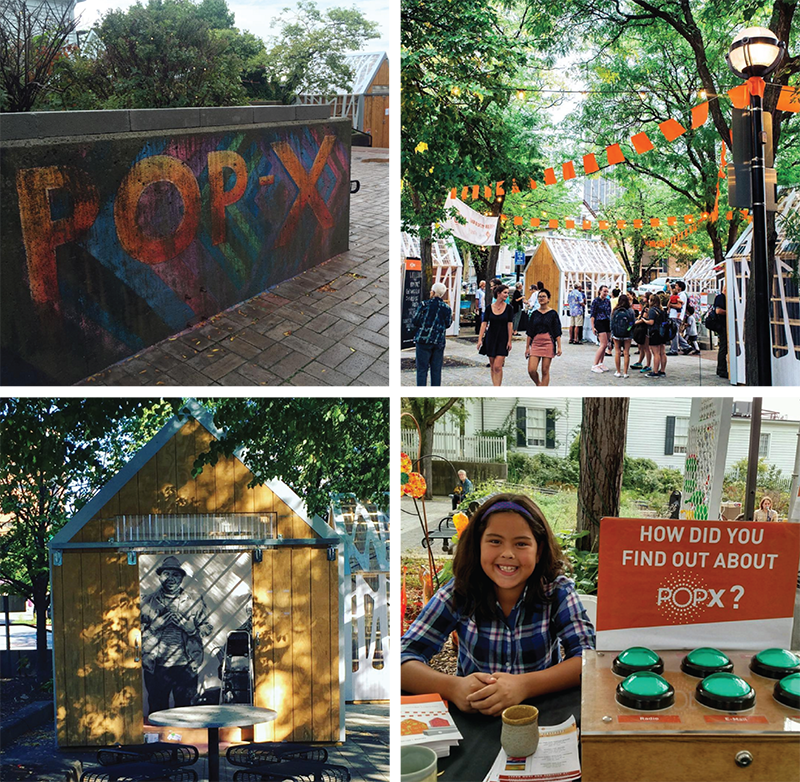
It may sound like lofty praise, but it’s becoming readily apparent that POP•X is one of the most important events on the contemporary Ann Arbor visual arts calendar. It’s a curious blend of some of our most talented arts groups and individual artists tacitly stepping out of their comfort zone.
The polish and professionalism on display in the installation site was POP•X 2016’s conventional strength—and its non-conformity was the fact that the event took place at all. While this seeming contradiction may be paradoxical to some, it follows seamlessly (perhaps even providentially) from a trajectory that fits the mood of our time.
For the fact is: POP•X fills a gap in our local visual arts that’s been all-too-lacking for some time on our arts calendar. Tucked nicely in downtown’s Liberty Plaza, the installation site was as tidy and manageable as an arts event could be in contrast to the overwhelming behemoth that annually invades Ann Arbor over the course of a week in July. That massive congregation may be ostensibly devoted to the arts, but it’s not really about art. Rather it’s a merchandizing juggernaut that allows the entire community to celebrate the idea of art.
By contrast, POP•X 2016 is a different thing altogether. It partakes of the slightly off-kilter vibe of the mid-20th century “happening.” Granted, it’s far tamer than the Allan Kaprow inspired performance art which sought to perplex as much as it meant to elucidate. But then again, everything slows down as it matures.
There’s instead a touch of the provocateur in POP•X 2016. And the art is of sufficient quality as to gently mask this tension. Instead, as would have been noted by the countercultural Fluxus group of this same mid-20th century period, it’s the sheer concreteness of POP•X that democratizes the activity. There’s no artificial boundary to the event (outside of its physical boundary) because the only border to POP•X 2016 is territorial and this is a logistical distinction.
Whether referencing Kaprow’s performance art or Fluxus’ abstraction, it was one of Neo-Dada's conceits that art be taken off the wall—Pop Art, Environmental Art, Conceptual Art, Optical Art, and other likeminded art forms of this stripe—sought to reinterpret the concept of art altogether. Yet one of the aesthetic ironies of Modernism was that even these kinds of art were still typically found confined to the gallery setting with all the expectations of such pretensions.
Let’s just suffice to say POP•X 2016 bursts though the aesthetic fourth wall of the gallery mentality by gleefully setting up shop outdoors and letting the setting itself serve its basis. But the conventionality of the “art” market has also restricted the possibilities of democratizing the aesthetic potential.
By contrast, POP•X effectively uses the conventions of art to work in an allied configuration that expands these possibilities. Indeed, it’s likely (on the presumption that Ann Arbor is wise enough to continue in this vein) that the possibilities of POP•X have not really yet been broached.
If only for the reasons mentioned above: There’s a homey feel to the POP•X 2016 spirit that’s channeled through the professionalism of the artists and art groups on display. The impulse is clearly there: For example, Lisa Waud’s incarnation of her Detroit-based Flower House utilized her installation to craft a display of nature that threatened to burst from its confine. And although it was based on the limitation of its video monitors, there is a remarkable amount of possible expansion in Donald Harrison and Martin Thoburn’s invigorating four-channel installation roaming Ann Arbor from each direction via its Liberty Plaza starting point.
Effectively—and, again, presuming our arts community is wise enough to build on this remarkably dexterous POP•X format—we still haven’t seen what POP•X 2016 can really be. The possibilities are there; just as the evolution of the village lies in the flexibility of the pavilion format. And this is the most exciting—as well as most important—element of the format.
As is evident from other places and events, contemporary art is clearly reconsidering itself at this time through the adventurousness of its practitioners. It was most evident in the mid-to-late 20th century through the reincarnation of ceramics, fabrics, and functional design.
This is the fundamental and continual challenge of all aesthetics. And POP•X is on the vanguard of this most recent artful transition. So the only real question then is what this change can be?
Because if POP•X 2106 is any indication, we don’t really know yet. For it’ll be the task of our local artists and arts groups as well as visionaries like the Ann Arbor Art Center’s Omari Rush to nurture the concept through its possible growth.
Rather than hope that we see a POP•X again—think in terms of how we see it again. For this is the test of the visual arts.
John Carlos Cantú has written on our community's visual arts in a number of different periodicals.
POP•X is an annual ten-day festival presented by the Ann Arbor Art Center. POP•X 2016 was Thursday, September 22 through Saturday October 1, 2016 from noon to 8pm at Liberty Plaza Park, 255 East Liberty St, Ann Arbor. To learn more visit popxannarbor.com or the POP•X Facebook event page. POP•X is free and open to the public.


































